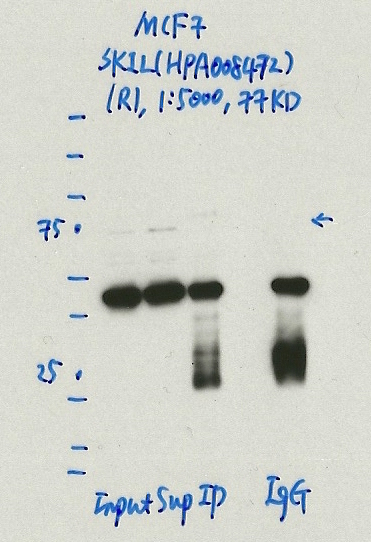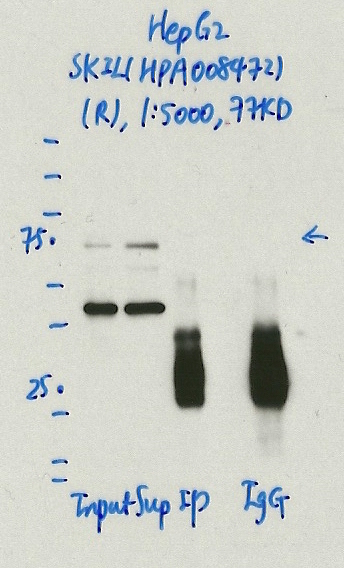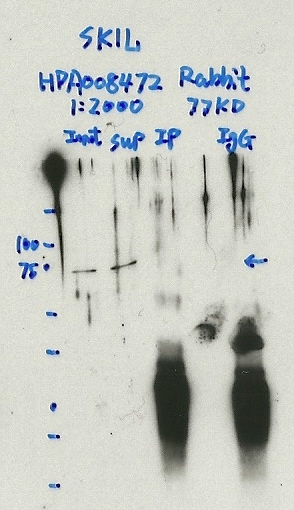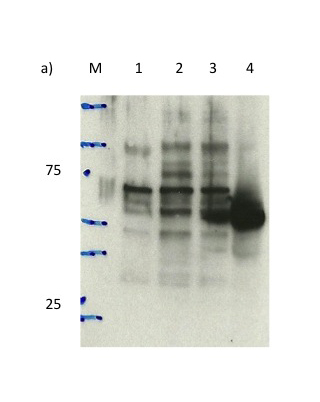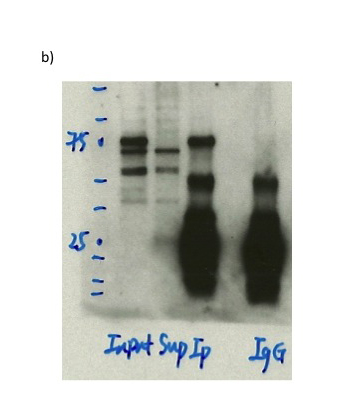ENCAB000BNW
Antibody against Homo sapiens SKIL
Homo sapiens
GM12878, K562
characterized to standards
Homo sapiens
any cell type or tissue
partially characterized
Homo sapiens
HepG2, liver
not characterized to standards
- Status
- released
- Source (vendor)
- Sigma
- Product ID
- HPA008472
- Lot ID
- R02251
- Characterized targets
- SKIL (Homo sapiens)
- Host
- rabbit
- Clonality
- polyclonal
- Purification
- affinity
- Isotype
- IgG
- Antigen description
- Ski-like protein recombinant protein epitope signature tag (PrEST)
- Antigen sequence
- SPDKRTCHWGFESAKWHCYLHVNQKYLGTPEEKKLKIILEEMKEKFSMRSGKRNQSKTDAPSGMELQSWYPVIKQEGDHVSQTHSFLHPSYYLYMCDKVVAPNVSLTSAVSQSKELTKTEASKSISRQSEKAHSSGKLQ
- External resources
Characterizations
SKIL (Homo sapiens)
not submitted for review by lab
- Caption
- Immunoprecipitation was performed on nuclear extracts from the cell line: MCF-7, using the antibody HPA008472. The blot shows western blot analysis of input, flowthrough, immunoprecipitate and mock immunoprecipitate using IgG.Molecular Weight: 77.0
- Submitted by
- Denis Salins
- Lab
- Michael Snyder, Stanford
- Grant
- U54HG006996
- Download
- 1062_1_SKIL_HPA008472_MCF7.jpg
SKIL (Homo sapiens)
not submitted for review by lab
- Caption
- Immunoprecipitation was performed on nuclear extracts from the cell line: HepG2, using the antibody HPA008472. The blot shows western blot analysis of input, flowthrough, immunoprecipitate and mock immunoprecipitate using IgG.Molecular Weight: 77.0
- Submitted by
- Denis Salins
- Lab
- Michael Snyder, Stanford
- Grant
- U54HG006996
- Download
- 1062_2_SKIL_HPA008472_HepG2.jpg
SKIL (Homo sapiens)
not submitted for review by lab
- Caption
- Immunoprecipitation was performed on nuclear extracts from the cell line: GM12878, using the antibody HPA008472. The blot shows western blot analysis of input, flowthrough, immunoprecipitate and mock immunoprecipitate using IgG.Molecular Weight: 77.0
- Submitted by
- Denis Salins
- Lab
- Michael Snyder, Stanford
- Grant
- U54HG006996
- Download
- expt1063_3-SKIL-HPA008472.jpg
SKIL (Homo sapiens)
not submitted for review by lab
- Caption
- Immunoprecipitation was performed on nuclear extracts from the cell line: HEK293T, using the antibody HPA008472. The blot shows western blot analysis of input, flowthrough, immunoprecipitate and mock immunoprecipitate using IgG.Molecular Weight: 77.0
- Submitted by
- Nathaniel Watson
- Lab
- Michael Snyder, Stanford
- Grant
- U54HG006996
- Download
- Expt1121_1-SKIL-HPA008472.JPG
SKIL (Homo sapiens)
K562
exempt from standards
- Caption
- Immunoprecipitation was performed on nuclear extracts from the cell line K562 using the antibody HPA008472. Lane 1: input nuclear lysate. Lane 2: material immunoprecipitated with antibody. Lane 3: material immunoprecipitated using control IgG. Marked bands were excised from gel and subjected to analysis by mass spectrometry. Target molecular weight: 77.0.
- Submitter comment
- We analyzed the whole marked band, including what looks to be immunoreactive signal in the IgG control.
- Reviewer comment
- Marked band looks to also be detected in the IgG control. However, in the subsequent mass-spec analysis, SKIL is found to be specifically enriched in the IP and not in the IgG control.
- Submitted by
- Nathaniel Watson
- Lab
- Michael Snyder, Stanford
- Grant
- U54HG006996
- Download
- SKIL (HPA008472).JPG
SKIL (Homo sapiens)
Method: immunoprecipitation followed by mass spectrometry
compliant
- Caption
- IP followed by mass spectrometry. Briefly, protein was immunoprecipitated from K562 nuclear cell lysates using the antibody HPA008472, and the IP fraction was loaded on a 10% polyacrylamide gel (NuPAGEBis-Tris Gel) and separated with an Invitrogen NuPAGE electrophoresis system. The gel was stained by ColloidialCoomassie G-250 stain, gel fragments corresponding to the bands indicated were excised. Then proteins were trypsinized using the in-gel digestion method. Digested proteins were analyzed on an Orbitrap Elite mass spectrometer (Thermo Scientific) by the nanoLC-ESI-MS/MS technique. Peptides were identified by the SEQUEST algorithm and filtered with a high confidence threshold (Peptide false discovery rate < 1%, 2 unique peptides per protein minimum, mass error < 10 ppm).
- Submitter comment
- SHMT2, KIF20A, MORC3, SF3B3, PARN, SUGP1, CIZ1 and G3BP1 are not DNA binding transcription factors.
- Reviewer comment
- CIZ1 might be a sequence-specific TF? https://www.ncbi.nlm.nih.gov/pubmed/12824700. However, the ENCODE Antibody Review panel reviewed the reference on June 26, 2017 and determined that more recent papers consider CIZ1 a co-activator and the degenerate consensus motif cited in the reference is not convincing evidence of it being a sequence-specific DNA binding protein.
- Submitted by
- Nathaniel Watson
- Lab
- Michael Snyder, Stanford
- Grant
- U54HG006996
- Download
- SKIL_HPA008472 final.pdf
SKIL (Homo sapiens)
GM12878K562HepG2liver
compliant
- Caption
- a) Western blot analysis of nuclear lysates prepared from multiple cells lines loaded in the order: GM12878, K562, HepG2, Liver using the antibody HPA008472.
- Reviewer comment
- Major band smaller than expected size of ~77kD (not indicated on image or caption) but there are multiple bands.
- Submitted by
- Trupti Kawli
- Lab
- Michael Snyder, Stanford
- Grant
- U54HG006996
- Download
- SKIL_HPA008472_WB_a.jpg
SKIL (Homo sapiens)
K562
compliant
- Caption
- b) Immunoprecipitation was performed on nuclear extracts from the cell line: K562, using the antibody HPA008472 .The blot shows western blot analysis of input, flowthrough, immunoprecipitate and mock immunoprecipitate using IgG. Expected size ~77 kDa.
- Submitted by
- Trupti Kawli
- Lab
- Michael Snyder, Stanford
- Grant
- U54HG006996
- Download
- SKIL_HPA008472_WB_b.jpg
